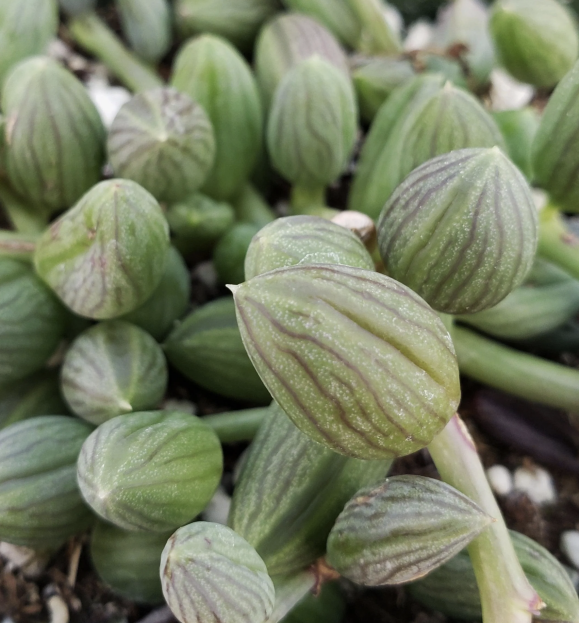
Senecio herreanus, commonly known as String of Watermelons or String of Beads, is a unique trailing succulent that adds charm to any indoor plant collection. With its plump, oval-shaped leaves featuring green and purple streaks, this plant closely resembles its relative, String of Pearls (Senecio rowleyanus), but with a more elongated, watermelon-like appearance.
This fast-growing, drought-tolerant succulent is perfect for hanging baskets or shelves where its delicate vines can cascade beautifully. While it's relatively easy to care for, proper light, watering, and soil conditions are key to keeping it healthy. Here's everything you need to know about growing and caring for String of Watermelons!
String of Watermelons thrives in bright, indirect light. It does best when placed near a south- or east-facing window, where it can receive plenty of filtered sunlight throughout the day. If grown indoors, supplementing with a grow light can help maintain its vibrant coloring and encourage healthy growth.
While this plant can tolerate some direct sunlight, too much intense sun exposure can cause the leaves to become scorched or shriveled. On the other hand, insufficient light can lead to leggy growth, where the vines stretch out, and the leaves become sparse.
Like most succulents, Senecio herreanus is drought-tolerant and prefers to dry out between waterings. Water only when the top 1-2 inches of soil feel completely dry. During warmer months, this may mean watering once every 1-2 weeks, while in the cooler months, watering can be reduced to once every 3-4 weeks.
Overwatering is the most common cause of problems with this plant, often leading to root rot & mushy leaves. To avoid this, always use a pot with drainage holes and empty any excess water from saucers or decorative pots.
A well-draining soil mix is essential for Senecio herreanus. A succulent or cactus mix works well, but you can also create your own potting mix by combining:
Using a terra cotta pot with drainage holes can further help prevent excess moisture buildup, reducing the risk of rot.
This plant thrives in warm temperatures between 65-80°F (18-27°C) and does not tolerate frost. If temperatures drop below 50°F (10°C), the plant can suffer damage. Keep it indoors during the winter or in a warm, sheltered location if grown outside.
String of Watermelons adapts well to normal household humidity and doesn’t require additional misting. If you live in an extremely dry climate, occasional misting or using a humidifier can help keep it healthy, but be careful not to overdo it, as excess moisture can lead to fungal issues.
During the growing season (spring and summer), feed the plant with a diluted liquid succulent fertilizer every 4-6 weeks to encourage healthy growth. Avoid fertilizing in the fall and winter, as the plant enters a dormant period and requires fewer nutrients. Over-fertilizing can lead to weak, leggy growth and may cause more harm than good.
Pruning is not essential but can help keep your String of Watermelons looking full and bushy. Trim any leggy, overgrown, or dead vines using sterile scissors. This will encourage new growth and help the plant maintain its compact, trailing shape.
Wipe the leaves occasionally with a damp cloth to remove dust, allowing the plant to absorb more light efficiently.
One of the best things about Senecio herreanus is how easy it is to propagate! If you want to create new plants or fill in sparse areas, follow these steps:
Once the new plant is established, care for it as you would a mature String of Watermelons!
No, String of Watermelons is toxic to cats and dogs if ingested. The plant contains compounds that can cause gastrointestinal discomfort, vomiting, and drooling in pets. Keep it out of reach, especially if you have curious animals in your home.